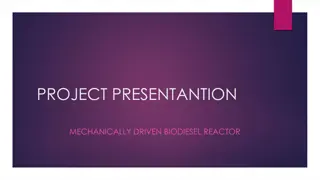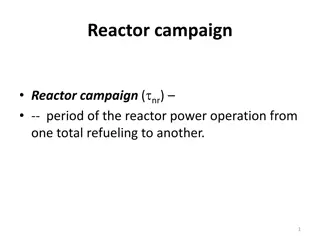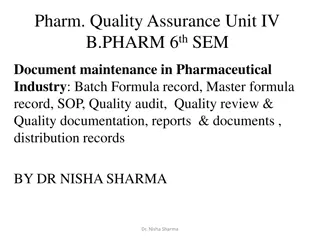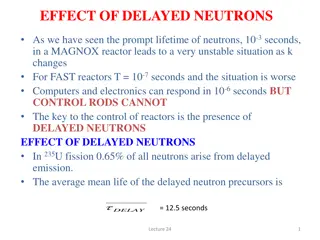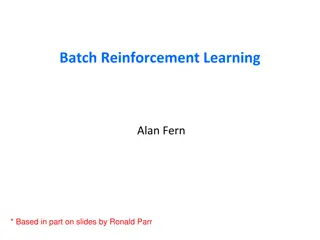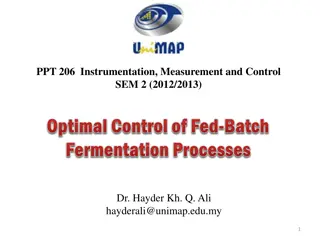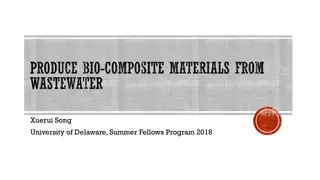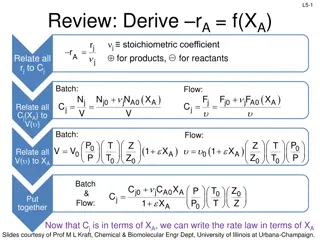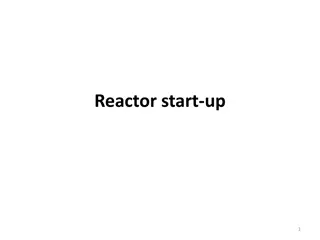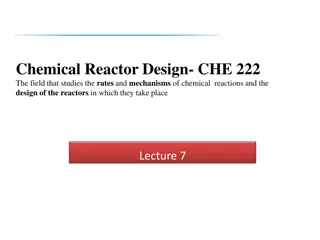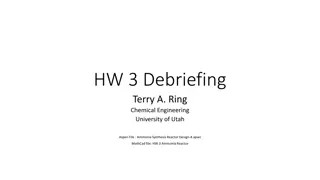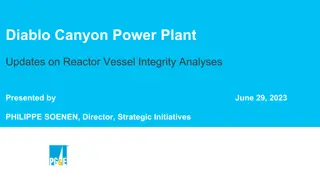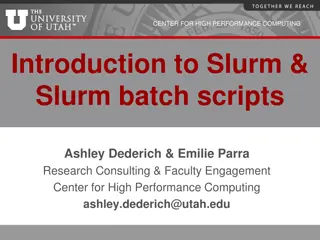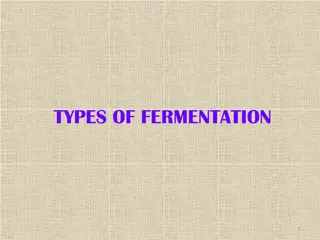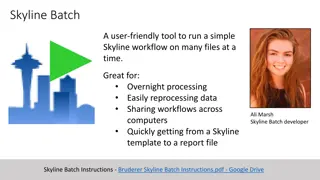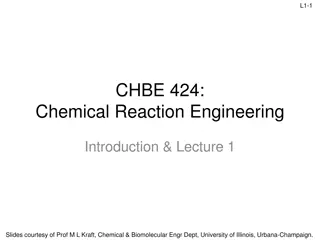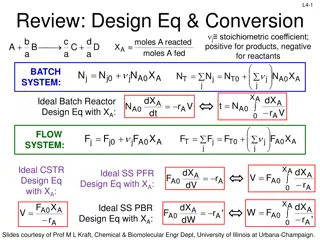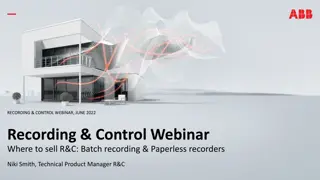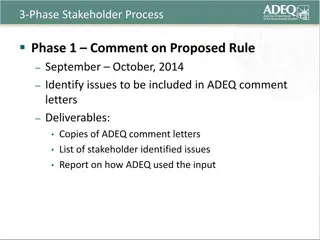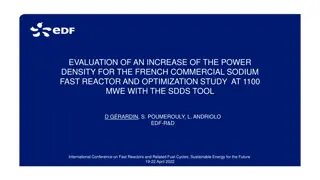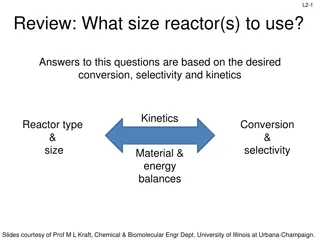Mechanically Driven Biodiesel Reactor for Village-Level Production
This project introduces a mechanically-driven biodiesel reactor designed to empower older women caregivers in Kenya by utilizing a pedal-operated system for biodiesel production from non-edible oils. The reactor, driven by a treadle sewing machine, aims to provide a sustainable energy solution while
5 views • 18 slides
Reactor Campaign in Nuclear Power Operations
Reactor campaign in nuclear power operations is crucial for ensuring safe and efficient reactor power operation. It involves managing reactivity margin, fuel residence time, nominal power, and effective days of operation. Reactor campaigns are influenced by various factors such as fuel elements' res
2 views • 64 slides
Batch Record Maintenance in Pharmaceutical Industry: Essential Guidelines and Requirements
Detailed documentation is crucial in the pharmaceutical industry to ensure the quality and consistency of each batch of products. Batch records, consisting of batch processing and packaging records, contain vital information such as product details, processing stages, personnel responsibilities, equ
3 views • 45 slides
Role of Delayed Neutrons in Reactor Control
Delayed neutrons play a crucial role in controlling nuclear reactors by providing a means to adjust reactivity. These delayed neutrons, emanating from fission processes in 235U, have a longer mean lifetime compared to prompt neutrons. This characteristic allows for a more manageable reactor operatio
2 views • 15 slides
Batch Reinforcement Learning: Overview and Applications
Batch reinforcement learning decouples data collection and optimization, making it data-efficient and stable. It is contrasted with online reinforcement learning, highlighting the benefits of using a fixed set of experience to optimize policies. Applications of batch RL include medical treatment opt
2 views • 47 slides
Principles of Fed-Batch Fermentation in Biotechnology
Explore the concept of fed-batch fermentation, a key technique in biotechnological processes. This method involves adding nutrients in controlled doses based on specific criteria to optimize cell growth and minimize undesirable metabolic pathways. Fed-batch systems allow for high cell densities and
20 views • 24 slides
Reactor Sizing and Conversion in Chemical Engineering
This chapter explores the sizing of Continuous Stirred Tank Reactors (CSTR) and Plug Flow Reactors (PFR) using conversion values and overall conversion. It covers the definition of conversion, batch reactor design equations, design equations for flow reactors, and more. The content delves into the m
3 views • 17 slides
Reactor Sizing: Conversion, Selectivity, and Kinetics Overview
Understanding reactor design involves considerations such as desired conversion, selectivity, and kinetics. Key concepts include rate laws, molar balances, and reactor types. Through molar balance equations and reactor design processes, one can derive essential equations for ideal batch, CSTR, and P
3 views • 20 slides
Research on Producing Bio-Composite Materials from Wastewater Using Filamentous Bacteria and Polyhydroxyalkanoates
This project conducted at the University of Delaware aimed to evaluate the potential of using filamentous wastewater microorganisms as reinforcement and polyhydroxyalkanoates (PHA)-accumulating microorganisms as a biorenewable matrix for bio-composite materials. Filamentous bacteria were analyzed fo
3 views • 13 slides
Chemical Reactor Design Principles
Explore the fundamentals of chemical reactor design, including stoichiometry, reaction rates, and reactor scale-up. Learn to derive rate laws and design equations in terms of conversion for batch, CSTR, and PFR reactors. Discover the logic behind isothermal reactor design and calculation of required
3 views • 21 slides
Reactor Start-up and Neutron Multiplication in Subcritical Reactors
Reactor start-up is a crucial operation that transitions a reactor from a subcritical state to a critical state by carefully adjusting reactivity levels. In a subcritical reactor, the neutron density should decrease over time but may not reach zero due to certain factors. Neutron multiplication fact
6 views • 66 slides
Machine Learning for Molten Salt Reactor Safeguards
Molten salt reactors face challenges in material accounting due to liquid fuel which precludes traditional safeguards. This project proposes a two-step approach involving the development of measurement signatures created by material diversion, and a machine learning model to distinguish normal react
5 views • 18 slides
Chemical Reactor Design: Rates, Mechanisms, and Reactor Types
The field of chemical reactor design encompasses studying reaction rates, mechanisms, and designing reactors for various processes. Factors such as reaction type, production scale, cost, safety, and more influence the choice of reactor scheme. Understanding reactor systems and applying engineering j
1 views • 15 slides
Ammonia Reactor System Design and Optimization Study for High Efficiency
This material discusses the design and optimization of an ammonia synthesis reactor system for maximizing conversion efficiency while minimizing CAPEX costs. Various factors such as managing heat effects, reaction runaway prevention, and cooling profiles are explored. Recommendations include using a
7 views • 10 slides
Overview of Chemical Reactor Design and Operation
Chemical reactor design involves studying the rates and mechanisms of chemical reactions, as well as the design of reactors for these reactions on a commercial scale. This field combines principles from thermodynamics, chemical kinetics, fluid mechanics, mass transfer, heat transfer, and economics t
2 views • 12 slides
Diablo Canyon Power Plant Reactor Vessel Integrity Analyses Update
Updates on Diablo Canyon Power Plant's reactor vessel integrity analyses were presented by Philippe Soenen, Director of Strategic Initiatives, on June 29, 2023. The analysis includes background information, reactor vessel surveillance coupon withdrawal plans, and the request for Nuclear Regulatory C
4 views • 9 slides
Introduction to Slurm and Slurm Batch Scripts Overview
Overview of Slurm and Slurm batch scripting presented by Ashley Dederich and Emilie Parra from the Center for High Performance Computing. The talk covers what Slurm is, preparing Slurm jobs, accounts, partitions, CHPC storage resources, environment variables, batch directives, basic commands, runnin
1 views • 64 slides
Overview of Different Types of Fermentation Processes
Explore the various types of fermentation processes including batch fermentation, fed-batch fermentation, continuous fermentation, solid-state fermentation, anaerobic fermentation, and aerobic fermentation. Each process has its own advantages and disadvantages, influencing factors such as sterilizat
4 views • 18 slides
Chemical Reactor Design: Unsteady State and Nonisothermal Reactors
Developing energy balances for unsteady state and nonisothermal reactors is essential for designing efficient chemical reactors. The energy balances involve terms such as heat flow, work done, energy accumulation, and mass flow, which impact the reactor's performance. By considering factors like pha
3 views • 29 slides
Job and Batch Costing in Industries
Job and Batch Costing are methods used in industries to ascertain the cost of specific jobs or batches separately. Job Costing is ideal for dissimilar or non-repetitive industries, while Batch Costing treats each batch as a cost unit. Both methods help in cost analysis, profitability assessment, and
2 views • 7 slides
Efficient Skyline Batch Workflow Tool for Processing Multiple Files
Utilize Skyline Batch, a user-friendly tool developed by Ali Marsh, to run simple Skyline workflows on multiple files efficiently. This tool is ideal for overnight processing, reprocessing data easily, and sharing workflows across different computers. Quickly transform Skyline templates into report
4 views • 4 slides
Introduction to Chemical Reaction Engineering
Chemical Reaction Engineering (CRE) is crucial for understanding how chemical reactors operate in various processing operations. This field involves reactor design by integrating factors such as thermodynamics, kinetics, fluid mechanics, heat transfer, and economics. CRE aims to effectively design a
4 views • 16 slides
Review of Chemical Reactor Design Concepts and Numerical Integration Methods
This presentation covers various topics related to chemical reactor design, including batch systems, flow systems, ideal reactor design equations, CSTRs, PFRs, and PBRs. It also discusses the numerical evaluation of integrals using different methods such as Simpson's rules. Slides courtesy of Prof.
2 views • 25 slides
Chemical Reaction Engineering: Rates, Mechanisms, Reactor Design
Chemical Reaction Engineering (CRE) delves into understanding the rates and mechanisms of chemical reactions, along with reactor design principles. This field explores how different variables impact reaction kinetics and optimal reactor configurations for efficient processes. Studying CRE involves a
3 views • 27 slides
Adaptive Stream Processing Using Dynamic Batch Sizing
This content discusses the concept of adaptive stream processing using dynamic batch sizing. It covers topics such as batched stream processing, latency considerations, static batch intervals, control module behavior, dynamic batch sizing goals, and early solutions in the field. It also delves into
2 views • 22 slides
Non-Stationary Reactor Xenon Poisoning When Shedding Load to Zero
In a non-stationary reactor scenario, xenon poisoning becomes a critical issue when shedding load to zero. Such conditions cause the formation of an iodine pit, potentially impacting reactor performance and safety. Understanding and managing xenon and iodine behavior during load shedding is essentia
3 views • 82 slides
Recording & Control Webinar - Batch Recording & Paperless Recorders
This webinar discusses the importance of batch recording and paperless recorders in product recalls, typical applications, benefits, and how to specify and operate batch functionality. Learn how these tools provide key information for product identification, fault detection, and batch recall. Explor
2 views • 33 slides
Recording & Control Webinar - Where to Sell R&C: Batch Recording & Paperless Recorders
The intricacies of batch recording and paperless recorders in the "Recording & Control Webinar" presented by Niki Smith, Technical Product Manager. Dive into topics like product recalls, benefits of batch recording, typical applications, and more. Gain insights on batch functionality, specifying rec
0 views • 4 slides
Evaluation of Power Density Increase for French Sodium Fast Reactor at 1100 MWe
This study evaluates the increase of power density for the French commercial sodium fast reactor and explores optimization at 1100 MWe using the SDDS Tool. The research conducted by GerardIN, S. and Poumerouly, L. delves into enhancing the reactor's performance and efficiency through power density e
2 views • 17 slides
Dynamic Batch Processing
Various types of batch processing, including running routines in the background, scheduling programs, and using dynamic operations. Learn about dynamic batch processors, date formulas, Unix environment variables, and more. Enhance your understanding of batch entries, parameter definitions, and stand
1 views • 42 slides
Reactor Molar Balance Equations Overview
This educational material introduces the concept of reactor molar balance equations for batch reactors, continuous stirred-tank reactors (CSTRs), and plug flow reactors (PFRs). The focus is on understanding the process of deriving design equations rather than rote memorization of the equations thems
2 views • 20 slides
Reactor Design Review and Rate Data Analysis
Learn about isothermal reactor design with mole balance setup, generation, and accumulation equations. Understand how to derive design equations in terms of conversion for different reactor types. Explore the method of excess for determining reaction orders and rate constants. Analyze rate data usin
14 views • 21 slides
Reactor Design Equations and Considerations for Optimal Performance
Explore the principles of reactor design based on conversion, selectivity, and kinetics while utilizing molar balance equations to determine reactor size and type. Learn how to apply molar balance equations to ideal batch, CSTR, and PFR reactors for efficient process design. Courtesy of Prof. M.L. K
3 views • 20 slides
Multiple Steady States in CSTR
Explore the concept of multiple steady states in a Continuous Stirred-Tank Reactor (CSTR) through the intersection of mass balance and energy balance equations, illustrating how different sets of conditions can lead to various reactions and outcomes within the same reactor. Discover the implications
3 views • 25 slides
Reactor Molar Balance Example Problems
Today, we will use Molar Balance Method (BMB) to derive reactor design equations. Learn the process without memorizing equations. Review basic molar balance concepts for batch reactor, CSTR, and PFR. Understand ideal reactor conditions and design equations for each type.
2 views • 7 slides
Isothermal Reactor Design Logic - Mole Balances and Rate Equations
Explore the fundamentals of isothermal reactor design through mole balances and rate equations for various reactor types. Understand the design equations in terms of conversion for batch, CSTR, and PFR reactors. Delve into examples of combining reaction rates and design equations for reactor operati
2 views • 21 slides
Chemical Reaction Engineering: Rates, Mechanisms, and Reactor Design
Chemical Reaction Engineering (CRE) delves into the study of rates, mechanisms, and the design of reactors for chemical reactions. Explore complex reactions in liquid and gas phases, multiple reactions, reactor mole balance summaries, and stoichiometry concentrations. Understand the nuances of batch
2 views • 34 slides
Reactor Design Equations and Rates for Different Reactors
Derive stoichiometric coefficients and reaction rates for reactor design equations, combining recipes and reaction rates for different reactors. Understand the logic of isothermal reactor design and calculate conversion time in batch reactor operations. Explore reactor scale-up and sizing algorithms
0 views • 26 slides
Batch and Flow Reactor Design Equations and Sizing Techniques
Explore the design equations and conversion calculations for batch and flow reactors, along with numerical evaluation methods for integrals. Learn how to determine reactor volumes for achieving specific conversions and understand the principles behind reactors in series. Visual aids and formulas pro
2 views • 15 slides
Steady States and Reactor Design Analysis
Explore the concept of multiple steady states in CSTRs, intersections of mass and energy balance equations, and reactor stability. Learn about heat removal terms, reactor stability criteria, and unsteady state nonisothermal reactor design. Discover how to analyze reactions in CSTRs under different c
1 views • 25 slides
